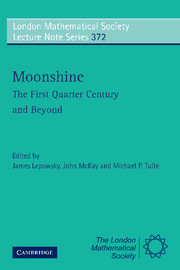 Moonshine - The First Quarter Century and Beyond
Moonshine - The First Quarter Century and Beyond Book contents
- Frontmatter
- Contents
- Preface
- Schedule of Talks
- Characters of Crossed Modules and Premodular Categories
- On the Injectivity of the Kudla-Millson Lift and Surjectivity of the Borcherds Lift
- Ordered Spanning Sets for Vertex Operator Algebras and their Modules
- Friendly Giant Meets Pointlike Instantons? On a New Conjecture by John McKay
- Modularity of Trace Functions in Orbifold Theory for ℤ-Graded Vertex Operator Superalgebras
- Twisted Modules for Vertex Operator Algebras
- Vertex Operators and Sporadic Groups
- The Algebraic Meaning of Being a Hauptmodul
- Borcherds' Proof of the Conway-Norton Conjecture
- On the Connection of Certain Lie Algebras with Vertex Algebras
- Vertex Operators and Arithmetic: How a Single Photon Illuminates Number Theory
- Rational Vertex Operator Algebras and their Orbifolds
- Quasi-finite Algebras Graded by Hamiltonian and Vertex Operator Algebras
- On Certain Automorphic Forms Associated to Rational Vertex Operator Algebras
- Moonshine and Group Cohomology
- Monstrous and Generalized Moonshine and Permutation Orbifolds
- New computations in the Monster
Characters of Crossed Modules and Premodular Categories
Published online by Cambridge University Press: 06 July 2010
- Frontmatter
- Contents
- Preface
- Schedule of Talks
- Characters of Crossed Modules and Premodular Categories
- On the Injectivity of the Kudla-Millson Lift and Surjectivity of the Borcherds Lift
- Ordered Spanning Sets for Vertex Operator Algebras and their Modules
- Friendly Giant Meets Pointlike Instantons? On a New Conjecture by John McKay
- Modularity of Trace Functions in Orbifold Theory for ℤ-Graded Vertex Operator Superalgebras
- Twisted Modules for Vertex Operator Algebras
- Vertex Operators and Sporadic Groups
- The Algebraic Meaning of Being a Hauptmodul
- Borcherds' Proof of the Conway-Norton Conjecture
- On the Connection of Certain Lie Algebras with Vertex Algebras
- Vertex Operators and Arithmetic: How a Single Photon Illuminates Number Theory
- Rational Vertex Operator Algebras and their Orbifolds
- Quasi-finite Algebras Graded by Hamiltonian and Vertex Operator Algebras
- On Certain Automorphic Forms Associated to Rational Vertex Operator Algebras
- Moonshine and Group Cohomology
- Monstrous and Generalized Moonshine and Permutation Orbifolds
- New computations in the Monster
Summary
Abstract
A general procedure is presented, associating a premodular category to a finite crossed module, generalizing the representation category of the double of a finite group, and the extent to which the resulting premodular category fails to be modular is explained.
Introduction
Modular Tensor Categories (MTCs for short) have attracted much attention in recent years, which is due to the recognition of their importance in both pure mathematics – 3-dimensional topology, representations of Vertex Operator Algebras (VOAs for short) – and theoretical physics (Rational Conformal Field Theory, Topological Field Theories). They are also closely related to Moonshine: a most interesting (and mysterious) example of a Modular Tensor Category, which is responsible for some of the deeper aspects of Moonshine, is the MTC associated to the Moonshine orbifold, i.e. the fixed point VOA of the Moonshine module under the action of the Monster: note that this MTC is yet to be rigorously constructed.
As in every branch of science, a deeper understanding of Modular Tensor Categories requires a suitable supply of examples. Since the work of Huang, we know that the module category of any rational VOA (satisfying some technical conditions) is modular, but this important result doesn't help us that much, because VOAs are pretty complicated objects usually hard to deal with. This leads to the desire of associating MTCs to simpler and more accessible algebraic objects. There are several such constructions, a most notable case being the one that associates to a finite group the module category of its (Drinfeld) double.
- Type
- Chapter
- Information
- Moonshine - The First Quarter Century and BeyondProceedings of a Workshop on the Moonshine Conjectures and Vertex Algebras, pp. 1 - 11Publisher: Cambridge University PressPrint publication year: 2010
- 3
- Cited by


